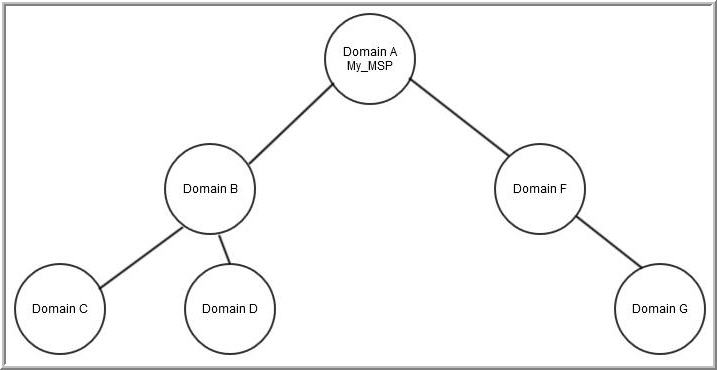Attribute Inheritance Overrides
Attribute inheritance is relevant primarily in multi-tenancy environments where StorageConsole domains are used to partition the database to maintain security controls. In this configuration, a hierarchical structure provides a parent-child relationship that controls access to data and also a structure for inheriting configurations from parents. For example, a Managed Services Partner (MSP) supports many client companies, each with its own StorageConsole domain. See the
Hierarchical Domain Structure for Attribute Inheritance diagram. Attributes created at the MSP domain are inherited by the child domains. In this case, the child domains may want to
Override Inherited Attribute Values, since it is likely that each company would have its own values for an attribute.
Likewise, an enterprise may simply want to use StorageConsole domains to segment the data within its environment. For example, subsidiaries or divisions within an organization have different business assets and therefore different reporting needs. In this case, an enterprise might configure a root domain, with sub-domains for each of its subsidiaries. An attribute defined for the parent company’s domain will be inherited by its subsidiaries.
Use the
Hierarchical Domain Structure for Attribute Inheritance diagram to visualize a hierarchy that supports attribute inheritance.

Figure 24.1 Hierarchical Domain Structure for Attribute Inheritance
Attributes have the following inheritance characteristics, based on a domain hierarchy:
• An attribute at the parent level is visible to all of its children.
Example: An attribute created at Domain A will be visible to all other domains.
• Children inherit attributes and values from any domain that is higher in its hierarchy path.
Example: An attribute created at Domain B will be visible only to Domains C and D. Likewise, an attribute created at Domain A will be visible to both Domains F and G.
• Duplicate attribute names are not allowed in a single hierarchy path. When creating an attribute, StorageConsole checks for duplicate attribute names and it will not create the attribute if it already exists in either a child or parent domain.
Example: Duplicate attribute names cannot exist in the A-F-G Domain path.
• Duplicate attribute names are allowed in sibling hierarchies.
Example: Domain B could have an attribute that is a duplicate of a name in Domain F.
Override Inherited Attribute Values
Often, attributes inherited from a parent to a child provide necessary report filtering. However, the parent’s attribute values may not be relevant for the child company. In this case, the child can override the list of values inherited from its parent.
Note: Overriding attributes is relevant only in multi-domain/multi-tenancy environments.
Use Case 1
Consider a Managed Services Partner (MSP) that supports many client companies. In this scenario, the MSP might have an attribute named Client with values that list all of its client company names. The MSP does not want this list to be publicly available to all of its clients. In this case, the MSP can choose one of the following options:
• Uncheck the Allow Inheritance box so that sub-domains cannot see the attribute in the Inventory or in a report scope.
• Override the values in each of the client domains so that they cannot see the root domain’s values. An administrator at the parent domain or the client domain can override the values for the attribute at the client’s domain. See also,
Managing Attributes.
Use Case 2
Likewise, as shown in the
Use Case for Overrides of Attribute Values diagram, the Business Units listed for the root domain may not be relevant for the child domains. In this case, the child domains need to have an override of the list of values.
Figure 24.2 Use Case for Overrides of Attribute Values
Note: For inherited attributes, you are
not permitted to modify
attribute names in child domains. However, you can modify/override the list of values and you can enable/disable inheritance for domains that are lower in the hierarchy. See
Editing or Renaming Attributes.



